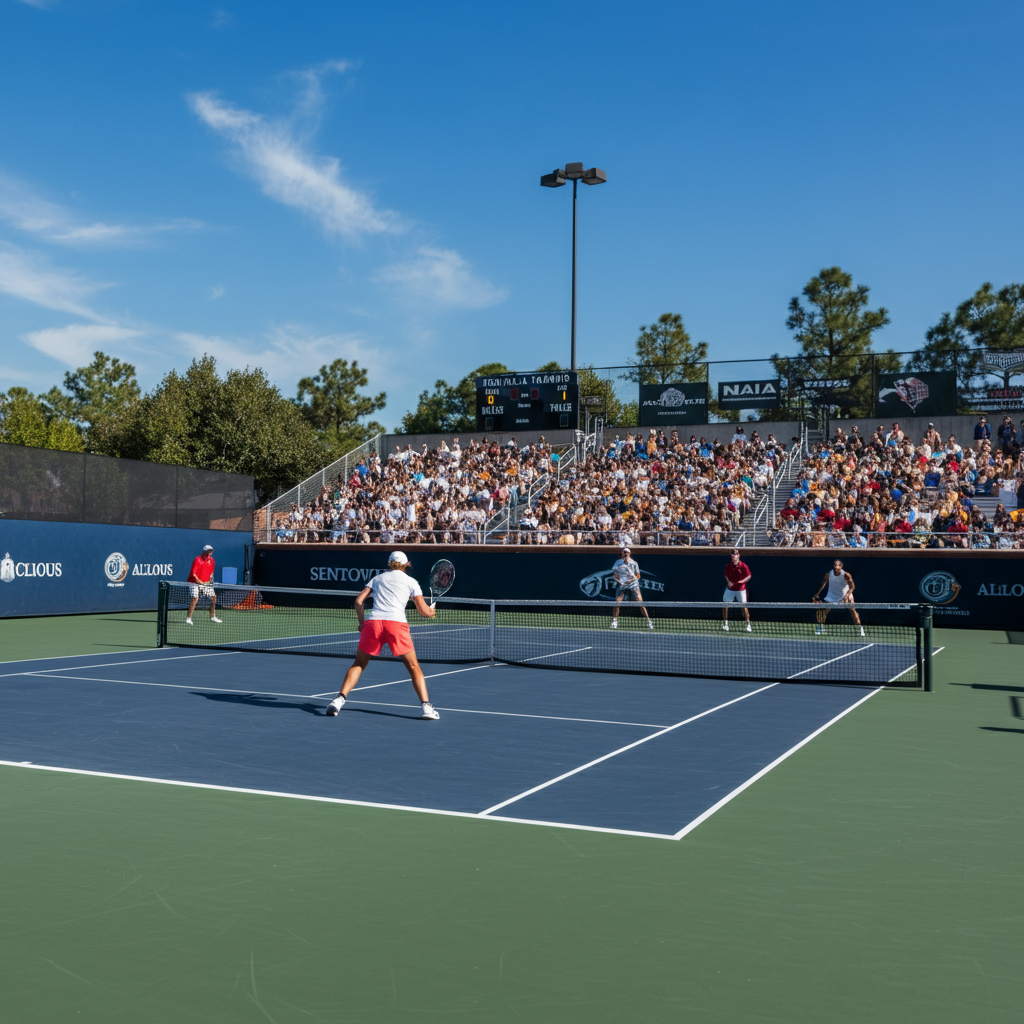
Introduction to NAIA Tennis
One of the most thrilling and convenient options for student-athletes to play at the collegiate level while achieving their academic objectives is through NAIA tennis. Tennis has a special place in the National Association of Intercollegiate Athletics’ (NAIA) objective to provide meaningful athletic experiences, which has been promoting excellence in small college athletics for decades.
Compared to other collegiate tennis divisions, NAIA tennis offers special chances. NAIA tennis fosters an atmosphere where student-athletes can genuinely flourish on and off the court by emphasizing academic success and character-driven athletics. For thousands of tennis players in the US and abroad, NAIA tennis is a desirable alternative because of the organization’s dedication to creating well-rounded people.
The NAIA tennis scene is always changing, drawing gifted athletes who want to strike a balance between academic success and competitive sports. In contrast to bigger leagues, NAIA tennis preserves a small-town setting where coaches can give each player individualized attention. One of the key features that draws players and families to tennis is its individualized approach to teaching and mentoring.
Any student-athlete thinking about pursuing this path must comprehend the options and structure of NAIA tennis. NAIA tennis provides a full collegiate experience that equips students for success outside of their tennis careers, including championship competitions and scholarship opportunities.
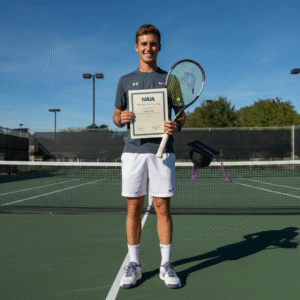
History and Evolution of NAIA Tennis
With the first women’s tennis championships in 1981 and the first men’s tennis championships in 1966, NAIA tennis has a long and illustrious history. Three distinct championships—team, singles, and doubles—are competed at each event; the men’s championship has been held yearly since 1966, while the women’s championship has been held yearly since 1981.
Character development, academic success, and competitive greatness have been NAIA tennis’s guiding principles throughout its existence. The top small college tennis programs from all around the country have come to participate in the competitions, which have increased in popularity and significance. NAIA tennis’s development shows the organization’s dedication to giving student-athletes worthwhile chances that they might not otherwise have at larger universities.
Over the years, the championship structure has stayed the same, placing equal emphasis on team and individual performance. NAIA’s tennis players are able to strive for both personal and team success thanks to this dual focus. The structure promotes a balanced style of tennis that fosters the growth of both individual and collaborative talents.
While preserving its basic principles, tennis has also adjusted to contemporary recruiting methods and technological advancements. While maintaining the interpersonal connections that characterize the NAIA experience, the incorporation of digital technologies for recruitment and eligibility administration has increased accessibility to tennis for potential student-athletes.
NAIA Tennis Championship Structure
The framework of the NAIA tennis tournament is intended to give participating programs the most competitive opportunity possible. The competitive depth of NAIA tennis is demonstrated by the 24-team competition for the 73rd Annual UTR Sports NAIA Men’s Tennis National Championship. The top programs from throughout the nation come together for the championship competition, which marks the end of the NAIA tennis season.
Players can compete for numerous titles during the event week because to the championship format, which consists of team, singles, and doubles competitions. Whether they are team players, solo competitors, or doubles experts, our all-inclusive system guarantees that players of all skill levels may succeed. There are numerous routes to achievement and recognition thanks to the diversity of competitions offered by NAIA’s tennis tournaments.
Approximately 700 players compete in the NAIA National Championships, traveling from all across the country. This noteworthy level of involvement highlights tennis’s broad appeal and competitive spirit. Student-athletes, coaches, and families from all around the nation come together to celebrate tennis during the championship week.
The Mobile Tennis Center in Mobile, Alabama, has recently hosted the competition, which has always been held at top-notch venues. NAIA tennis’s dedication to offering top-notch playing conditions for its championship events is reflected in the location selection. Programs are able to organize efficiently and establish a tradition around the championship experience because of the continuous venue.
Dominant Programs in NAIA’s Tennis
There are a few of programs that have made a name for themselves as dominant forces in NAIA tennis. With eleven NAIA national titles, Redlands has been the most successful men’s tennis program. Georgia Gwinnett, on the other hand, has the most titles among current NAIA programs, with ten.
With fourteen NAIA national titles, Auburn-Montgomery has been the most successful program in women’s NAIA’s tennis. Georgia Gwinnett is also in first place among active NAIA programs with ten titles. Georgia Gwinnett’s accomplishments in both the men’s and women’s tennis divisions show the program’s all-encompassing approach to greatness as well as its capacity to find and nurture talent in both fields.
Other schools wishing to establish competitive tennis programs can take inspiration from these prosperous NAIA’s tennis programs. Strong coaching, successful recruiting, academic assistance, and the institution’s dedication to tennis excellence are some of the reasons behind their success. Aspiring tennis players and coaches can gain important information by researching these schools.
In NAIA tennis, the dominance of some programs sets aspirational goals for other schools. The accomplishments of Georgia Gwinnett and Auburn-Montgomery show that sustained success in tennis can be attained with perseverance and careful preparation. Other NAIA’s tennis programs are motivated to raise their own bar and aim for championship-level performance by their accomplishments.
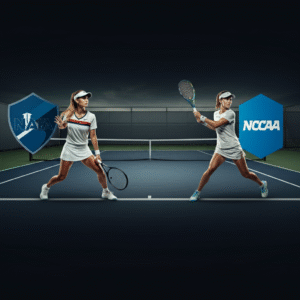
NAIA Tennis Eligibility Requirements
Any student-athlete thinking about pursuing this path must comprehend the eligibility rules for NAIA tennis. In order to be eligible for NAIA, you must: (1) have completed high school; and (2) meet two of the three requirements listed below: have a GPA of at least 2.0, finish in the top half of your graduating class, and have an ACT score of at least 18 or SAT score of at least 860.
The purpose of these NAIA tennis eligibility requirements is to maintain appropriate standards for athletic participation while making sure that student-athletes are ready for the scholastic demands of collegiate tennis. Because two of the three requirements can be met, tennis is able to accommodate a variety of student types while upholding academic standards.
To participate in sports at an NAIA institution or university, a student-athlete must register with the NAIA Eligibility Center. All aspiring NAIA’s tennis players must complete this registration process before they may compete at the collegiate level. The official repository for establishing and preserving qualifying status is the eligibility center.
The requirements for international students who want to play NAIA’s tennis are a little different. In addition to providing the appropriate paperwork, students who completed high school outside of the United States or its territories must fulfill two of the following three requirements: Get at least a 970 on the SAT or an 18 on the ACT. These global regulations guarantee that, while upholding proper academic standards, tennis will continue to be available to gifted players from all around the world.
Scholarship Opportunities in NAIA Tennis
Student-athletes who want to play collegiate tennis can benefit greatly from NAIA’s tennis scholarships. NAIA’s tennis scholarships are frequently split among several team members, giving more players the chance to earn financial aid than in larger divisions that might only provide full scholarships to a select few players.
The NAIA tennis scholarship system gives coaches the freedom to allocate funds according to the requirements of their program and the resources at their disposal. Because of this flexibility, NAIA’s tennis players may be eligible for partial scholarships, which can greatly lower the cost of their college education when paired with additional financial aid and academic help.
Athletic prowess is not the only factor considered for NAIA’s tennis scholarships. When awarding scholarships, coaches take into account a student’s character, academic achievement, and potential to contribute to the team culture. The NAIA’s tennis organization’s emphasis on producing whole student-athletes rather than just athletic success is in line with this all-encompassing approach to scholarship distribution.
NAIA tennis scholarships are renewable, which encourages athletes and students to keep up their high standards. Throughout their collegiate tennis careers, players can anticipate ongoing scholarship support if they uphold their academic standing and make valuable contributions to their teams. Because of this steadiness, NAIA tennis players may concentrate on their growth rather than worrying about money all the time.
Recruiting Process for NAIA Tennis
Compared to other collegiate divisions, the NAIA tennis recruiting process is very different, providing special benefits for coaches and potential student-athletes. More direct communication between coaches and candidates is made possible by NAIA tennis recruiting, which opens up chances for deep connections to form during the hiring process.
Potential student-athletes can be contacted at any time by NAIA tennis coaches, offering both sides flexibility. Because of this open contact approach, NAIA’s tennis programs are able to find and connect with talented players at an early stage of their high school careers. Better coach-player matches and more fruitful collegiate experiences are frequently the outcomes of the individualized attention provided by NAIA tennis recruiting.
Compared to other divisions, the NAIA’s tennis recruiting schedule is typically more lenient, giving hopefuls more time to plan their college careers. NAIA’s tennis players who might be late bloomers or who require more time to hone their academic credentials in addition to their tennis skills will especially benefit from this extended schedule.
Fit between player and program is emphasized in NAIA;s tennis recruiting, which takes into account more than just tennis skill. Coaches seek athletes who will uphold academic standards, represent their schools honorably, and positively impact team culture. By taking a thorough strategy to recruiting, NAIA’s tennis programs are guaranteed to draw student-athletes who share their goals and values.
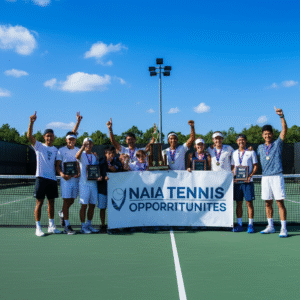
Academic Excellence in NAIA Tennis
The NAIA tennis program is centered on academic success, with student-athletes expected to attain academic excellence while pursuing their athletic objectives. In order to assist players in juggling their twin responsibilities to tennis and education, NAIA tennis programs usually offer strong academic support services.
Smaller class sizes and more individualized attention from faculty members define the academic climate in NAIA tennis. NAIA’s tennis players can form strong bonds with their instructors in this small-class environment and get the help they require to excel academically. Tennis players frequently get superior academic results at NAIA universities because of the individualized attention they receive.
From business and education to science and the liberal arts, NAIA’s tennis players usually pursue a wide range of academic interests. Tennis players can pursue their intellectual pursuits while still juggling their sports commitments thanks to the flexibility of NAIA academic programs. The entire NAIA tennis experience is enhanced by this academic diversity, which also equips players for a variety of post-graduation job options.
NAIA’s tennis programs uphold academic criteria that guarantee players are ready for success after graduation. The focus on academic success fosters a culture in which NAIA’s tennis players are proud of both their academic and athletic successes. The NAIA tennis program is known for its well-rounded approach to student-athlete development.
Training and Development in NAIA Tennis
In order to optimize each player’s potential and promote team unity and competitive performance, NAIA tennis offers training and development options. Comprehensive training plans that focus on mental preparation, physical conditioning, technical ability, and tactical game understanding are usually provided by NAIA tennis schools.
NAIA tennis coaches place a strong emphasis on helping players grow as individuals within a team environment. In order to create individualized development plans that cater to each player’s needs, coaches work closely with each player to determine their strengths and areas for growth. Compared to larger university tennis programs, this one-on-one time is frequently more comprehensive.
While retaining the individualized touch that defines the NAIA experience, NAIA’s tennis training integrates contemporary sports science concepts. To maximize player growth, programs make use of performance tracking, fitness testing, and video analysis. For NAIA tennis players, a holistic development environment is created through the use of technology and conventional coaching techniques.
Character development and mental training are essential elements of NAIA’s tennis programs. In addition to teaching technical tennis skills, coaches place a strong emphasis on developing mental toughness, leadership abilities, and personal accountability. NAIA’s tennis players are prepared for success during and after their undergraduate careers by this all-encompassing approach to player development.
Facilities and Resources in NAIA Tennis
Although NAIA tennis facilities differ greatly between schools, many programs have made large investments to provide top-notch conditions for practice and competition. The investment in facility construction shows how many NAIA tennis programs are supported institutionally and how committed they are to provide student-athletes high-quality experiences.
Modern surfaces and amenities that facilitate year-round training and competition are frequently seen in NAIA tennis universities’ indoor and outdoor court facilities. Players can learn to be versatile and adjust to various playing circumstances thanks to the availability of diverse court surfaces in many NAIA tennis programs. The range of training settings available to NAIA tennis players improves their growth prospects.
With numerous programs integrating video analysis systems, ball machines, and fitness equipment made especially for tennis training, technology integration in NAIA’s tennis facilities is still developing. In addition to offering coaches tools to improve their instruction and player evaluation, these technology resources aid in the growth of NAIA’s tennis players.
The pride that schools have in their programs is shown in the repair and maintenance of NAIA’s tennis facilities. Positive training conditions and institutional dedication to the success of NAIA tennis programs are produced by well-maintained facilities. Reputable facilities are also crucial recruitment tools for luring in gifted potential student-athletes.
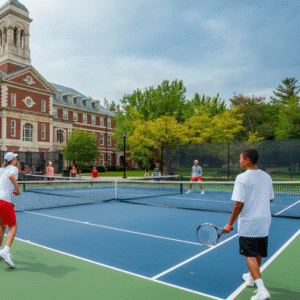
Competition Structure and Tournaments
While preparing for the national championships, NAIA tennis’s tournament schedule is thoughtfully crafted to offer significant competitive experiences all season long. Conference tournaments, invitational events, and dual matches that get teams ready for postseason play are all part of NAIA tennis’ regular season action.
The foundation of NAIA tennis is conference competition, with teams vying for conference titles that frequently grant automatic entry to national competitions. In NAIA tennis, the conference system fosters organic rivalries and guarantees that teams compete at suitable levels all season long. In order to qualify for the national championship, conference tournaments are essential first steps.
Eight of the best NAIA men’s tennis teams compete for a national title at the ITA NAIA National Men’s Team Indoor Championship. In addition to giving NAIA’s tennis teams more chances to compete, this indoor championship highlights the organization’s breadth of talent. Additionally, the indoor championship offers crucial tournament experience and permits competition during inclement weather.
NAIA tennis’s tournament structure places a strong emphasis on both team and individual success. Players can pursue individual success in singles and doubles contests in addition to competing for team titles. Different player strengths and preferences are accommodated by this dual focus, which opens up many avenues for success and distinction within NAIA’s tennis.
Coaching Excellence in NAIA Tennis
The qualities of a good NAIA tennis coach are commitment, knowledge, and a personal stake in the growth of their student-athletes. The chance to work closely with players and have a significant impact on their lives—both personally and athletically—is one of the main reasons NAIA tennis coaches frequently select this division.
In NAIA tennis, the coaching philosophy usually prioritizes long-term growth over immediate outcomes. In addition to preparing players for success in competition, coaches concentrate on developing players’ character, mental toughness, and foundational abilities. For NAIA tennis players, this developmental strategy produces long-lasting advantages that go well beyond their time in college.
A large number of NAIA tennis coaches have a wealth of coaching and playing experience. These coaches can act as mentors and role models for their players because of their educational background and tennis ability. The players’ collegiate careers are frequently followed by the personal bonds that form between NAIA tennis coaches and players.
Clinics, certifications, and networking events are some of the professional development possibilities available to NAIA tennis coaches, which help them stay up to date on the latest developments in sports science and tennis teaching techniques. Throughout their undergraduate careers, athletes will receive top-notch training because to NAIA tennis coaches’ dedication to ongoing progress.
Player Development Pathways
In NAIA’s tennis, player development takes many various forms, catering to a range of origins, abilities, and objectives. While some NAIA tennis players have a lot of experience competing in junior tournaments, others mostly learn their talents through club or high school tennis programs. NAIA tennis’s openness permits a range of developmental paths.
In NAIA’s tennis, the four-year development arc usually starts in the freshman year with the improvement of basic skills and team integration. As players advance in their NAIA’s tennis careers, they continue to hone their technical and tactical skills while assuming more leadership roles. In NAIA’s tennis, senior players frequently act as mentors to their junior counterparts, fostering an environment of lifelong learning and growth.
Beyond only honing technical skills, NAIA’s tennis players also receive leadership development, volunteer work, and career preparation. A lot of NAIA’s tennis schools include career development and life skills training in their overall player development approach. NAIA’s tennis players are guaranteed to be ready for success in their post-graduation pursuits because to this all-encompassing approach.
Because NAIA tennis programs are so close-knit, each player’s unique requirements and objectives may be met through customized development plans. Larger programs might not be able to offer the kind of focused instruction and in-depth feedback that coaches can. In NAIA’s tennis, this individualized focus maximizes potential and speeds up player growth.
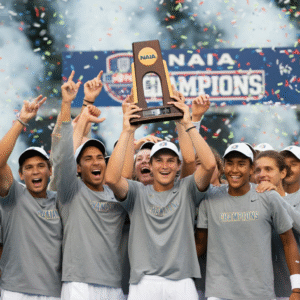
Academic Integration and Support
Student-athletes can excel in both their academic and tennis endeavors thanks to academic integration in NAIA tennis programs. Academics and athletics are carefully balanced so that NAIA’s tennis players can succeed in both without sacrificing their dedication to either.
Study halls, career counseling, academic monitoring, and tutoring are common academic support services offered in NAIA tennis programs. These tools assist NAIA’s tennis players in overcoming the difficulties of juggling their two responsibilities while upholding their high standards in each. The support system acknowledges that intellectual performance is just as significant as athletic success.
Academic requirements are taken into consideration when scheduling NAIA’s tennis events, and coaches strive to reduce conflicts between tennis obligations and class schedules. The dedication to student achievement that defines NAIA tennis programs is demonstrated by this regard for academic priorities. Although it takes careful planning, student-athletes benefit from the integration of their academic and sports schedules.
Professors frequently help student-athletes in their tennis aspirations and attend matches as part of their involvement with NAIA tennis programs. Because of this institutional backing, NAIA’s tennis players are able to feel appreciated for their academic and athletic accomplishments.
Scholarship Types and Financial Aid
There are several different types of NAIA’s tennis scholarships, giving schools and student-athletes options in how they set up their financial aid packages. Families can make well-informed decisions regarding collegiate tennis prospects by being aware of the many forms of financial aid offered by NAIA’s tennis.
Comprehensive aid packages can be created by combining academic scholarships, need-based help, athletic scholarships, and other types of financial aid in NAIA tennis. NAIA’s tennis players are frequently able to earn more comprehensive help thanks to this stacking of many aid categories than may be possible through athletic scholarships alone. One of NAIA tennis’s main advantages is its flexibility in merging aid sources.
In NAIA tennis, partial scholarships are sometimes offered, enabling coaches to divide up the allocated scholarship funds among several players. By using this distribution technique, NAIA’s tennis programs can help more student-athletes and create competitive teams. Players should be aware that when paired with other forms of financial assistance, partial scholarships can still offer substantial benefits.
In NAIA’s tennis, sports scholarships are frequently supplemented by merit-based financial aid linked to academic accomplishment. Generous academic scholarships are available at several NAIA schools, which can drastically lower the total cost of attendance. For many families, NAIA’s tennis is an economical alternative since it combines academic and athletic aid.
International Opportunities in NAIA Tennis
International student-athletes looking to play collegiate tennis in the United States are increasingly drawn to NAIA tennis. International players can pursue their academic and tennis objectives while adjusting to American college culture thanks to the friendly atmosphere and support networks found in NAIA tennis schools.
The NAIA tennis league’s talent pool and cultural diversity have grown as a result of international recruiting. Since skilled athletes from all around the world may make a substantial contribution to NAIA tennis programs, coaches aggressively seek out players from other countries. All players benefit from the international presence, which also fosters international relationships within NAIA tennis.
Additional documentation and evaluation procedures are part of the NAIA tennis eligibility process for international students. The procedure is doable with the right preparation and assistance, but students who completed high school outside of the United States or its territories must fulfill certain requirements and submit accurate documents. International recruits are frequently helped by NAIA tennis programs with the visa and eligibility procedures.
International NAIA tennis players can receive ongoing support with American collegiate culture, mentorship opportunities, and orientation programs as part of their cultural adaptation support. In addition to helping international players thrive in the classroom and on the tennis court, this support allows them to bring their distinct viewpoints to NAIA tennis programs.
Technology and Innovation in NAIA Tennis
With programs implementing a range of technological tools to improve training, recruiting, and competitive experiences, technology integration in NAIA’s tennis is still developing. NAIA tennis instructors may give players in-depth criticism on technique and strategy using video analysis tools, which speeds up player growth.
The way that NAIA’s tennis programs interact with potential student-athletes has been completely transformed by online channels for communication and recruitment. These tools give participants quick access to information about NAIA’s tennis options while enabling coaches to assess potential effectively. Players from a variety of geographic locations can now more easily access NAIA tennis thanks to the digital change.
Fitness tracking, match statistics, and training load management systems are examples of performance tracking technology used in NAIA tennis. Coaches can monitor player development and health and optimize training regimens with the use of these instruments. When it comes to training sophistication, NAIA’s tennis schools may effectively compete with larger programs thanks to the integration of performance technology.
For NAIA tennis schools to highlight their accomplishments and draw in potential student-athletes, social media and digital marketing have become crucial tools. In addition to helping NAIA’s tennis programs compete for top talent, professional presentation through digital platforms enhances their reputation and brand recognition.
Career Preparation Through NAIA Tennis
The NAIA tennis program places a strong emphasis on developing the abilities and qualities that will help players succeed after graduation, making career preparation a crucial part of the experience. Players can gain management and communication skills that will aid them in their professional careers by taking advantage of the leadership possibilities offered by NAIA tennis.
Beyond the tennis community, NAIA tennis offers networking opportunities for graduates, corporate executives, and professionals from a variety of industries. Numerous NAIA tennis teams have robust alumni networks that offer current and past players job possibilities and mentorship. These relationships frequently come in very handy when starting lucrative careers following college.
NAIA tennis players can retain their sports commitments while gaining real-world experience through internship and work-study options. Numerous NAIA schools provide flexible scheduling to provide professional development opportunities as well as tennis training. NAIA tennis players are prepared for success through this combination of professional, athletic, and academic training.
Professional performance is directly correlated with the time management and self-control abilities acquired via NAIA tennis. Former collegiate tennis players’ dedication and work ethic are frequently valued by employers. NAIA tennis alumni are desirable candidates for a variety of professional opportunities due to their mix of academic and athletic performance.
Conference Dynamics and Competition
NAIA tennis is built on conference competition, which forges organic rivalries and gives teams organized competitive settings all season long. Every NAIA tennis conference has its own unique competitive dynamics and character, presenting member institutions with a range of opportunities and difficulties.
The majority of NAIA tennis conferences are structured on regional closeness in order to reduce travel expenses and time away from classes, so geographic factors are crucial. This regional strategy encourages natural rivalries and makes it possible for nearby colleges to compete more frequently. By lowering travel requirements, the geographic arrangement also promotes the NAIA tennis’ emphasis on academic accomplishment.
In NAIA tennis, conference tournaments offer players and spectators thrilling competitive experiences while also serving as essential qualifying events for national championships. These competitions frequently establish automatic qualifiers for national titles and foster fierce rivalry that brings forth the best in NAIA tennis players.
Because NAIA tennis conferences fluctuate in strength and depth, programs can select competitive settings that fit their objectives and developmental stage. While some conferences offer numerous nationally ranked programs, others give up-and-coming schools the chance to compete competitively while honing their tennis skills.
Mental Training and Sports Psychology
In NAIA tennis, mental training acknowledges that in addition to physical and technical growth, psychological preparation is necessary for competitive performance. Sports psychology concepts are incorporated into the training plans of several NAIA tennis programs, which aids in the development of players’ mental toughness and competitive confidence.
In NAIA’s tennis programs, the demands and difficulties of competitive tennis naturally present chances for the development of mental skills. In order to improve competitive performance, coaches help athletes develop coping mechanisms, focus methods, and confidence-boosting practices. These cognitive abilities come in handy when playing tennis as well as when faced with other obstacles in life.
In NAIA’s tennis, team dynamics and individual psychology collide to create intricate problems that need careful handling. While preserving a positive team dynamic, coaches must strike a balance between the requirements of each individual player and the team’s objectives. Because NAIA’s tennis teams are usually tiny, these psychological factors are especially crucial for the success of the program as a whole.
NAIA tennis players frequently struggle with performance anxiety and competitive pressure, especially during crucial games and competitions. Improved outcomes and increased player satisfaction are frequently observed in programs that address these psychological aspects of competition. A key element of all-encompassing NAIA’s tennis growth is mental training.
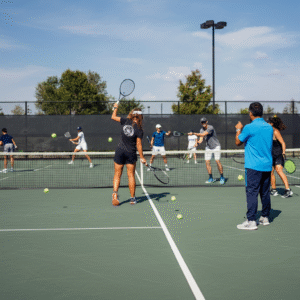
Health and Fitness in NAIA’s Tennis
Effective NAIA tennis programs must include injury prevention and physical fitness. Because competitive tennis is so demanding, it calls for extensive fitness regimens that focus on strength, flexibility, cardiovascular endurance, and movement patterns unique to tennis.
NAIA tennis strength and conditioning programs are designed to meet the unique requirements of the sport while taking student-athletes’ general growth and health into account. Numerous NAIA’s tennis schools collaborate with certified fitness experts to create training plans that maximize performance and reduce the chance of injury. The NAIA tennis ideals are in line with the emphasis on long-term player wellness.
Players in NAIA’s tennis programs benefit from nutrition education and support, which helps them maximize their energy levels and recuperation times. As tennis players progress in their competitive careers, it becomes more and more crucial to understand how to eat for optimal performance. To promote player health and performance, a number of NAIA’s tennis programs offer nutrition education and tools.
Early intervention and comprehensive care are key components of NAIA’s tennis injury prevention and management standards. NAIA tennis players who have access to sports training services are better able to stay healthy and safely resume competition following injuries. Better injury management outcomes are frequently the consequence of the individualized attention offered in NAIA tennis programs.
Travel and Competition Experience
In addition to exposing players to various competition contexts, NAIA’s tennis travel experiences offer priceless chances for team building and personal development. NAIA tennis’s travel component fosters players’ freedom and flexibility as they represent their schools in a variety of contexts.
Student-athletes have a variety of playing experiences at NAIA tennis competition venues, which range from small campus spaces to large tournament locations. NAIA’s tennis players gain adaptability and mental toughness via exposure to various court surfaces, weather conditions, and competitive environments. The player’s overall development is aided by these diverse encounters.
In NAIA tennis, team travel fosters relationships and opportunities for camaraderie among colleagues. Beyond the tennis court, enduring friendships and memories are frequently created through the common experiences of travel and competition. Traveling as a team adds to program culture and improves the NAIA’s tennis experience overall.
In order to maximize competitive prospects while keeping expenditures under control, NAIA’s tennis budget considerations and trip preparation need to be carefully managed. Numerous NAIA’s tennis teams take an innovative approach to travel, making use of regional competition and well-planned scheduling to deliver top-notch competitive experiences while staying below financial limits.
Alumni Success and Legacy
The long-lasting effects of the student-athlete experience and the job training these programs offer are illustrated by NAIA tennis alumni success stories. Many former NAIA tennis players credit their tennis experience with helping them acquire important life skills, and they have gone on to have successful careers in coaching, business, education, and other professional professions.
Although they are less frequent, professional tennis careers for NAIA tennis alumni are not unheard of; some former players go on to compete professionally or pursue employment in the tennis industry after graduation. Players who decide to continue playing tennis after college benefit from the foundation NAIA tennis offers, which also helps them get ready for other career options.
Many former players return to tennis as high school or collegiate coaches, demonstrating the popularity of coaching among NAIA tennis alumni. Coaching professions are well-prepared by the leadership and instructional abilities gained in NAIA tennis. A large number of current NAIA’s tennis coaches were once part of NAIA programs.
For current students and recent graduates, NAIA’s tennis alumni networks offer possibilities and continuous support. Successful professionals who are willing to mentor and help young people starting their careers are frequently a part of these networks. Alumni’s professional life frequently benefit from the connections made during their NAIA’s tennis careers.
Financial Considerations and Cost Management
Understanding the different costs of collegiate tennis and locating resources for financial aid are key components of cost management in NAIA tennis. Families thinking about playing NAIA’s tennis should consider all available financial aid opportunities while weighing the costs of school, room and board, equipment, and travel.
Equipment expenditures, tournament fees, and other tennis-related expenses that might not be covered by institutional assistance or scholarships should all be factored into the budget planning process for tennis. Families may plan appropriately for all related expenses and make well-informed decisions about participating in NAIA tennis by being aware of these additional charges.
Beyond athletic scholarships, financial aid frequently plays a significant part in helping families afford NAIA’s tennis. The total cost of participating in NAIA’s tennis can be considerably decreased by academic scholarships, need-based financial aid, work-study options, and outside scholarships. When thinking about tennis alternatives, families should look into all of the available aid choices.
Long-term professional benefits as well as immediate educational and athletic gains are taken into account when calculating return on investment for NAIA tennis. Beyond the obvious tennis advantages, NAIA tennis frequently makes the investment worthwhile through its networking opportunities, talent development, and educational chances.
Future Trends and Developments
With shifting interests in collegiate athletics, demographic shifts, and technology advancements, NAIA tennis’s future is still evolving. Prospective student-athletes and coaches can better prepare for the future of NAIA tennis competition and possibilities by being aware of these developments.
In addition to physical ability, character and academic success are becoming more and more important in tennis recruitment trends. This all-encompassing recruiting strategy guarantees that programs draw student-athletes who will enhance the culture of the university and is consistent with tennis principles. The long-term goals of NAIA’s tennis are reflected in the recruiting process’ emphasis on character development.
The use of technology in NAIA tennis is probably going to keep growing as programs integrate new resources for communication, analysis, and training. The difficulty for NAIA’s tennis schools will be striking a balance between the advancement of technology and the individualized attention and interpersonal connections that define the NAIA experience.
Increasing foreign recruitment, creating new competitive formats, and raising awareness of NAIA tennis accomplishments are some of the growth prospects in the sport. For NAIA tennis schools and student-athletes, these growth areas offer great opportunities for future growth and success.
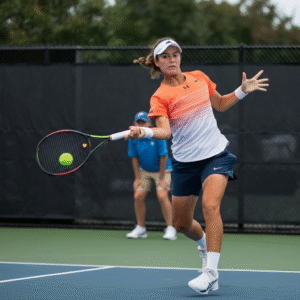
Getting Started in NAIA Tennis
It takes meticulous planning and preparation to start the route toward NAIA’s tennis, starting with knowing the eligibility rules and finding programs that fit each player’s skills and ambitions. To optimize their chances and preparation time, aspiring NAIA’s tennis players should start the process early in their high school careers.
Academic programs, regional preferences, team culture, coaching philosophy, and competitive level are some of the elements that should be taken into account when conducting research and identifying programs in tennis. The majority of players can discover programs that fit their aspirations and objectives because to the diversity of NAIA tennis programs. Good player-program matches are ensured by thorough investigation.
Communicating with NAIA tennis coaches should be educational, professional, and show that you genuinely care about the school and the tennis program. Prospects who have done their homework and are able to explain their reasons for being interested in particular NAIA tennis programs are valued by coaches. Successful coach-player relationships are built on a foundation of excellent communication during the recruiting phase.
Developing tennis skills, upholding academic standards, and cultivating character attributes consistent with NAIA principles are all part of preparing for tennis. Instead of concentrating only on tennis skills, the preparation process should cover every facet of the student-athlete experience. Prospects who are prepared have a higher chance of succeeding in NAIA tennis programs.
Campus Life and Student Experience
Campus life for NAIA tennis players combines athletic commitments with academic responsibilities and social opportunities, creating a rich and diverse collegiate experience. The smaller campus environments typical of NAIA institutions often provide close-knit communities where tennis players can develop meaningful relationships with classmates, faculty, and staff.
Student involvement opportunities beyond tennis are abundant at NAIA institutions, allowing tennis players to explore diverse interests and develop leadership skills in various contexts. Many NAIA tennis players participate in student government, academic clubs, community service, and other campus activities that enrich their collegiate experience.
Housing and dining experiences at NAIA institutions typically provide comfortable living arrangements and quality food service that support student-athlete needs. Many NAIA tennis players live on campus throughout their collegiate careers, creating strong connections to their institutions and fellow students. The residential experience contributes to the overall development and satisfaction of NAIA tennis players.
Social activities and entertainment options at NAIA institutions create opportunities for tennis players to enjoy their collegiate years while maintaining their commitments to tennis and academics. The balance between competitive athletics and social development is an important aspect of the NAIA tennis experience that contributes to overall student satisfaction.
Success Stories and Case Studies
NAIA tennis success stories highlight the opportunities offered by NAIA schools and the transformational potential of the student-athlete experience. These anecdotes highlight the variety of results that may be achieved via playing tennis and serve as motivation for both present and potential players.
Players that have won major academic honors, been accepted into graduate schools, and started lucrative professional careers are among the tennis players who have achieved scholastic success. These tales of academic achievement show that tennis players are capable of achieving both academic and athletic success.
Players who have fulfilled their competitive potential and helped their teams win at the national level are highlighted in tennis’s athletic achievement tales. Current tennis players are inspired by championship teams and individual title winners, who show off the level of competition that can be achieved in NAIA tennis.
Character development, leadership development, and conquering obstacles are common themes in NAIA tennis personal development narratives. These tales demonstrate the transformative power of playing tennis as well as the personal development that comes from being a student-athlete. NAIA tennis values are reflected in these stories’ emphasis on character development.
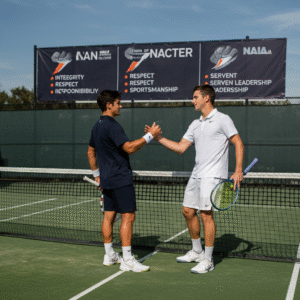
Conclusion: The NAIA Tennis Advantage
For student-athletes looking to combine competitive tennis with high-quality education in a nurturing setting, NAIA tennis provides a special and worthwhile road. Opportunities for holistic growth and development that go well beyond the tennis court are made possible by the individualized attention, character development, and academic integration that tennis offers.
A winning recipe for student-athlete success is created by the academic success and character development that NAIA institutions promote, along with the competitive excellence displayed in tennis tournaments. NAIA tennis players benefit from a model of long-term success that strikes a balance between academics and athletics.
NAIA tennis offers student-athletes weighing their collegiate tennis options the chance to follow their tennis goals while obtaining a top-notch education and making lifelong friends. Compared to larger, more impersonal settings, tennis programs’ supportive environment and individualized attention frequently result in more fulfilling and successful collegiate experiences.
Given the sustained increase in participation, the enhancement of facilities and resources, and the appreciation of the benefits that NAIA tennis programs offer, the future of NAIA tennis is bright. When student-athletes decide to play NAIA tennis, they are joining a legacy of success, morality, and excellence that will benefit them for the rest of their lives.





Leave a Reply